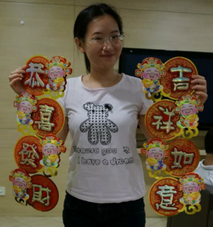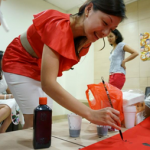By Rita Zhang
The Nanyang MBA Culture Club and Women in Business Club successfully co-organized the 2013 Chinese New Year Party at Graduate Hall Lounge It was a wonderful festival celebration event that gave all of the guests a happy , cheerful and maybe grand cultural banquet.
With a team of six mostly mainland Chinese people, except for one, led by Jennifer (Chen Yan), Amy, Wu Hao, Alex (Malaysian), Lily and Rayman (Lily’s boyfriend) ,we started the preparation as early as 12 noon. We went shopping at Sheng Siong supermarket near our campus. After almost four hours of grocery shopping, we managed to bring back: vegetables, beef, beers for the dinner and definitely Chinese FU Character and Spring Couplets to get us into the festive mood. It seems a short list but we ended up with so many shopping bags. However, many thanks to our classmates, Hantang Da Ge and Andy (American), for helping us to carry and deliver our food to the Graduate Hall.

At 4 p.m, we were busy preparing for the dinner at Graduate Hall kitchen. This year’s main menu is HOT POT, the must-have meal in almost every Chinese family during Chinese New Year. Hot pot is basically a way of cooking food in a pot , mainly boiling. Meow, Amy and Jennifer’s worked hard in washing all the vegetables and cutting radish. Albert (Indonesian) and Apiwat (Thai), for your help on our venue decoration! And yes, our Singaporean hosts, Amanda, Eng Soon, Weiming and Ingo (German) provided the hotpots for cooking!

By 6 p.m., the traditional Chinese Hot Pots were set on the table. Chinese cabbage, rape, mushrooms, radish, fried tofu, vermicelli rice (thin white noodles) are laid on the table around the hot pot. While waiting for the soup stock in the pot to boil, we gathered around the table impatiently with chopsticks and plates ready to attack. At the sight of boiling bubbles, we placed the food ingredients into the pot. And the countdown begins- Five minutes… two minutes… one minute… Hooray! It is ready! Oh yes, we have the special sauce prepared by Lily & Amy! Yummy! The sauce is sumptuous and complements the delicious food cooked hot pot style. This made us eat more! The lounge became warmer with the steam from hotpot and more than thirty people who are having hot pot together, in summer!
Nevertheless, this is the best time of the whole trimester-gatherings, enjoying with so many friends companion and enjoying hot pot
After 2 hours, we finallyfinished our dinner. We are now full and bloated. Nonetheless, we need to get into our sleek costumes for the Cheongsam Competition! Cheongsam or Qipao is a Chinese traditional costume which has been worn since the Manchu dynasty ruled China in the 17th century.
Before they wore the original qipao was wide and baggy. The one-piece dress featured a high neck and straight skirt. The qipao worn today are modeled after ones made in Shanghai in the 1920s. The modern qipao is a one-piece, formfitting, floor length dress that has a high slit on one or both sides. Modern variations may have bell sleeves or be sleeveless and are made out of a variety of fabrics. – About.com
Who will be our Miss. Cheongsam?


Finally, we have the winner…. No other than Henry (thorn among the roses), the only guy in traditional Chinese Changshan! The prize is a red envelope with $20! Thanks Mr. Changshan, for bringing us so much fun!

At 9 p.m after the contest, we started writing of Chinese FU Character. Put the red paper on the table, raise up the writing brush, dip the ink, and you can write Chinese Fu now- it is that simple??. Yes,it is that easy! You can do it! Don’t believe me? Look at Josephine’s professional gesture! Wish our Fu bring good luck and good fortune to everyone and to our Nanyang MBA! Thanks Hantang Da Ge again, for helping us to get the writing brushes, ink and red paper.

And that is how we celebrated the Chinese New year – with the company of our friends!
Chinese New Year is the longest and most important festival in the Chinese calendar. It is the time to bid farewell to the old year and welcome the new spring, to reconcile, forget all grudges and sincerely wish peace and happiness for everyone. Thanks to everyone, we have had an unforgettable Chinese New Year with you! Till the next one.
Culture Tips:
1. Spring Couplets – In Chinese poetry, a couplet (simplified Chinese: 对联; traditional Chinese: 對聯; pinyin: duìlián) is a pair of lines of poetry which adhere to certain rules (see below). Outside of poems, they are usually seen on the sides of doors leading to people’s homes or as hanging scrolls in an interior. A special, widely-seen type of couplet is the spring couplet (simplified Chinese: 春联; traditional Chinese: 春聯; pinyin: chūnlián), used as a New Year’s decoration that expresses happy and hopeful thoughts for the coming year. – Wikipedia
2. Hot Pot: Hot pot (simplified Chinese: 火锅; traditional Chinese: 火鍋; Mandarin Pinyin: huǒ guō), refers to several East Asian varieties of stew, consisting of a simmering metal pot of stock at the centre of the dining table. While the hot pot is kept simmering, ingredients are placed into the pot and are cooked at the table. Typical hot pot dishes include thinly sliced meat, leaf vegetables, mushrooms, wontons, egg dumplings, and seafood. Vegetables, fish and meat should be fresh. The cooked food is usually eaten with a dipping sauce. – Wikipedia
3. Cheongsam: Qipao or cheongsam (旗袍) are one-piece Chinese dresses that have been worn since the Manchu ruled China in the 17th century. The original qipao was wide and baggy. The one-piece dress featured a high neck and straight skirt. The qipao worn today are modeled after ones made in Shanghai in the 1920s. The modern qipao is a one-piece, formfitting, floor length dress that has a high slit on one or both sides. Modern variations may have bell sleeves or be sleeveless and are made out of a variety of fabrics. – About.com
You must be logged in to post a comment.